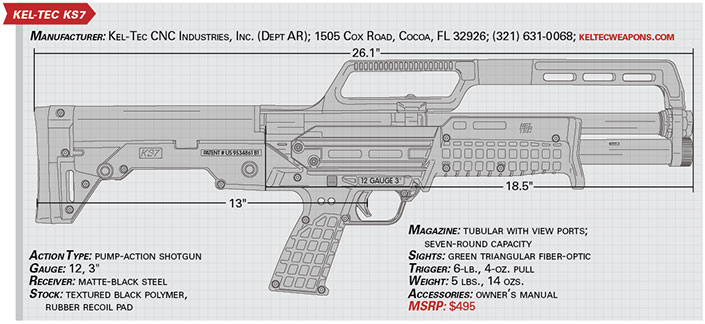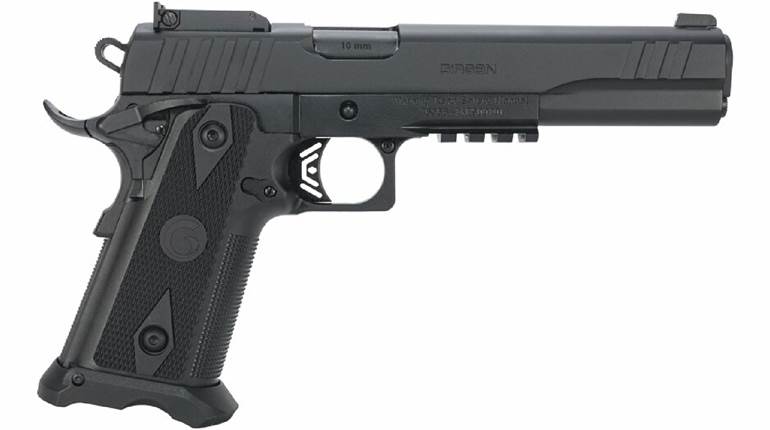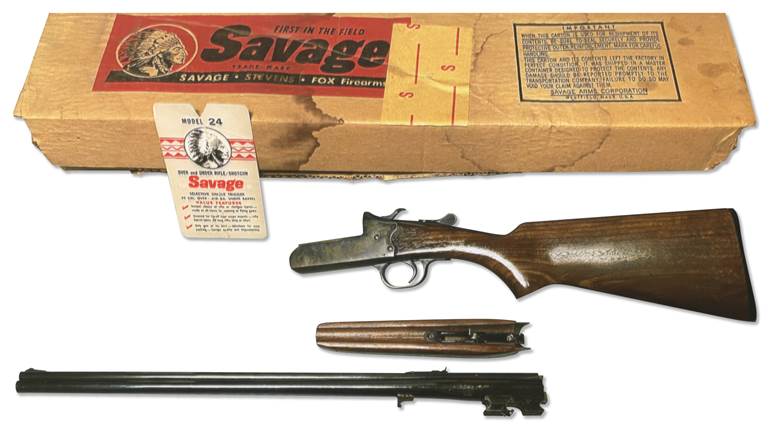
Often, around the time that the shooting industry settles down into a comfortable routine regarding one product niche or another, Kel-Tec will come along and give it a good swift kick in its complacency. For instance, most pistols of the past century that were chambered for .22 Long Rifle and designed for competition or casual plinking have featured single-stack, usually 10-round, magazines. Kel-Tec’s new CP33, on the other hand, uses an innovative quad-stack magazine design that holds 33 rounds—and it challenges rimfire pistol design on other levels as well.
In similar fashion, the company’s dual-magazine-tube, pump-action bullpup KSG shotgun took the market by storm in 2011 with its compact 26.1" overall length and 15-round ammunition capacity. Since then, longer and shorter versions of the KSG have been developed, but now the company has taken it in another direction with a slimmed-down single-magazine version called the KS7. The result is a handy, lightweight defensive shotgun that costs half as much as the original KSG.

The Kel-Tec CP33
In 2010, I had my first opportunity to handle Kel-Tec’s initial foray into the world of rimfire handguns at the annual SHOT Show in Las Vegas. It was the PMR-30 semi-automatic pistol chambered in .22 WMR. The pistol stands out from the crowd because of its unloaded weight of 13.6 ozs., light single-action trigger and unconventional pie-wedge magazine that holds up to 30 rounds of ammunition. Fans were quick to request a .22 Long Rifle version of the platform that would be significantly less expensive to feed.
But not too long after the PMR-30 started shipping, the United States experienced a serious ammunition shortage—one that many enthusiasts (and industry experts) didn’t see coming. In particular, there was a dearth of .22 Long Rifle ammunition as concerned consumers and speculators cleaned out the shelves of sporting goods and big-box stores across the nation. Some folks were so discouraged by the ammunition shortage that they traded in their rimfire guns for center-fire models. But by 2018 it was clear that the rimfire ammunition shortages were well and truly over, making 2019 a good year to bring to market the .22 Long Rifle CP33 semi-automatic pistol with its 33-round standard-capacity magazine.
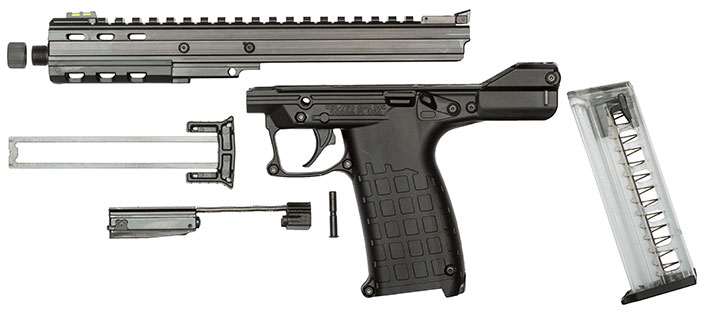
Although the CP33 sports controls, a grip frame and a magazine lifted from the PMR-30, the upper half of the pistol is noticeably different in several ways. The lower pressure levels produced by .22 Long Rifle ammunition allow the CP33 to employ a simple blowback-operated action instead of the hybrid blowback/locked-breech system required for firing .22 WMR. The PMR-30 has a slim 0.95" profile, a reciprocating slide assembly and just enough of a grip extension to protect the shooting hand from slide bite.
The CP33’s fixed aluminum upper is 1.16" wide and extends 2.5" beyond the backstrap of the grip. It’s interesting to note that the softer-shooting .22 Long Rifle pistol weighs 10 ozs. more than the .22 WMR version. But these differences make sense because the PMR-30 was designed as a lightweight trail gun while the CP33 is built for competitive target shooting and casual plinking at the range.
A vented, full-length aluminum housing supports the sight system and provides an integral 7.5" Picatinny optics rail. It is fixed in place to stabilize red-dot and magnified optics. It adds some weight but also works to stabilize the pistol during recoil. The front sight is a squared-off metallic housing with a bright green fiber-optic pipe. The fully adjustable square-notch rear target sight is outfitted with red fiber-optic dots. The muzzle of the barrel is threaded at 1/2x28 TPI for muzzle accessories, and the pistol ships with a thread protector installed. A vented, 2.75"-long aluminum housing is mounted below the barrel and provides a single M-Lok accessory slot for mounting a light or laser module.

The polymer charging handle is located behind the rear sight. It’s supported by two sheet metal action bars that cycle the bolt assembly. The handle’s sheet metal supports seem a bit flimsy for a competition gun, but they held up just fine over the course of this review without any issues. Just below the charging handle you’ll find left and right lanyard loops, not unlike those found on point-and-shoot cameras. Whether they’ll be put to work as wrist lanyard supports or single-point-sling attachment loops is yet to be seen.
The external controls are the same as those on the PMR-30, with a slide catch on the left side of the frame, bilateral safety levers and a magazine release located in the heel of the grip instead of behind the trigger housing. The polymer single-action trigger is housed in an undercut trigger guard with a flat face that can serve as a finger rest. The pistol tested for this review exhibited a 3-lb. trigger pull that felt clean and smooth.
 The wedge-shaped magazine is made of clear polymer with openings on both sides that are nearly an inch long. It’s been called a quad-stack magazine because a central steel post divides the ammunition into two double-stack columns. The heel-mounted magazine release may seem a bit odd for what is being marketed as a competition pistol, but it does have its advantages. The chances of unintentionally bump-releasing the magazine are close to nil, and it’s easy to operate either left- or right-handed. Although the release may be slower to operate, especially with magazines that do not drop free of the grip, the gun holds three times as much ammunition as typical 10- or 12-round single-stack target pistols. There is no magazine safety, so the pistol will fire when the magazine is removed from the grip.
The wedge-shaped magazine is made of clear polymer with openings on both sides that are nearly an inch long. It’s been called a quad-stack magazine because a central steel post divides the ammunition into two double-stack columns. The heel-mounted magazine release may seem a bit odd for what is being marketed as a competition pistol, but it does have its advantages. The chances of unintentionally bump-releasing the magazine are close to nil, and it’s easy to operate either left- or right-handed. Although the release may be slower to operate, especially with magazines that do not drop free of the grip, the gun holds three times as much ammunition as typical 10- or 12-round single-stack target pistols. There is no magazine safety, so the pistol will fire when the magazine is removed from the grip.
It’s important to remember that semi-automatic .22 rimfire pistols tend to be ammunition-sensitive at least some of the time. I have yet to find a single make or model that runs reliably with every load the market has to offer. While conducting a bench check of the 33-round magazine, I tried to load it with some Winchester bulk-box rounds that I’m currently using up for informal testing. Each round was obstinate about going into the magazine, and when it was about half-way full, the follower would go no farther. It was frustrating, to say the least.
After picking those rounds out of the magazine, I tried filling it again with different loads manufactured by Aguila, Browning, CCI, Federal, Remington and even a different load from Winchester. With the exception of that one Winchester load, the magazines loaded smoothly and easily. I took a few rounds of the stiff-loading ammunition to the range where it failed to feed properly with every shot fired. However, all of the test ammunition that fed easily into the magazine also ran reliably in the pistol. With the exception of a couple of duds found among bulk-box loads, the pistol hummed right along nicely for hundreds of rounds. The lessons learned are first, make sure to test new .22 pistols with a variety of ammunition types before buying a case of a given load. Secondly, pay attention when loading the CP33 magazines. If a particular load feels rough or sticky when loaded, most likely it’s not going to perform well in the pistol.

The CP33 proved to be a pleasure to work with at the range. It exemplifies the enjoyable, affordable, soft-shooting fun that rimfire pistols can provide. It feels light and well-balanced thanks to the grip’s more centralized location. Felt recoil is nearly non-existent, making it a good fit for almost all skill and experience levels. The sights are easy to see, and the trigger feels like it should cost more than it does. And who can complain about cutting magazine swaps by two-thirds? Some rimfire enthusiasts will not embrace the black polymer, sci-fi-blaster appearance of the CP33, but I, for one, appreciate the cool factor it brings to the table. With its modular polymer-and-aluminum construction, the future possibilities for colorful finish options and useful accessories are bright indeed.

The KS7
Although Kel-Tec did not invent the bullpup shotgun, the KSG certainly drove the concept into the mainstream American shooting market. The original bottom-ejecting, dual-magazine-tube model holds a total of 14 2¾" shells while avoiding any NFA tax stamps or paperwork by meeting the over-26"-length requirements for sporting and defensive shotguns. It’s been well-received by law enforcement agencies, correctional facilities and Special Forces. But it’s the KSG’s popularity with Joe Public that has kept it selling well for nearly a decade. Several other companies have developed their own double-tubed (and in some cases, double-barreled) scatter guns, but they have not been nearly as successful.
However, the KSG is not the best fit for some applications. It has an unloaded weight of 6 lbs., 14 ozs., which goes up by more than 1 lb. with 15 rounds of buckshot on board. The operational process of working with two magazine tubes is not everyone’s cup of tea, and the suggested retail pricing starts at $990—and goes up from there. Some enthusiasts would prefer to trim down the weight, work with the simplicity of just one magazine and pay less for the platform. Kel-Tec has answered these customer requests with the release of the slim KS7 12-ga. shotgun with a suggested retail price of $495.
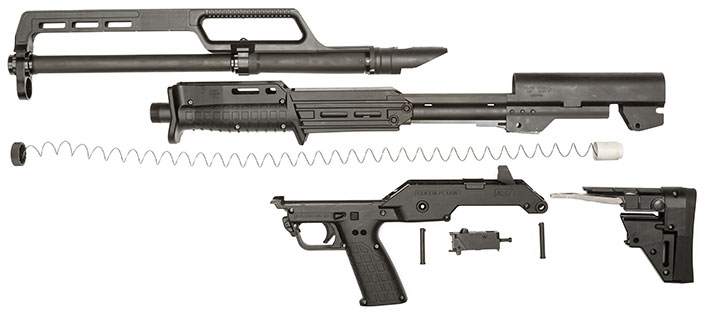
The KS7 pump-action clearly exhibits Kel-Tec’s signature design features. It’s called a bullpup because the action and ejection port are located behind the trigger group. The gun’s layout is bilateral, with just one downward-facing port for both loading and ejecting spent hulls. The liberal use of durable, high-impact polymer, precision-machined aluminum and strategically placed steel components reduces the gun’s weight to 5 lbs., 14 ozs., unloaded. It can hold six 3" shells or seven 2¾" shells in the magazine, which adds about half a pound to the weight. Along with being slimmer, the KS7 model sports some improvements not found on older models, and it’s easier to operate.
Among the most noticeable changes is the sight system. The KSG’s Picatinny-style rail, with no iron sights, has been replaced with a 2"-tall polymer sight channel. The front end is fitted with a green, triangular fiber-optic pipe with three M-Lok accessory slots to either side. The rear of the channel is configured to serve as a carry handle, much like the handle found on early AR-15. This sight and handle combo is removable if you prefer installing an optics rail.
A machined aluminum bracket, which also supports the magazine tube and sight channel, is secured to the muzzle of the barrel by means of two large nuts. The smooth-bore 18.5" barrel has a fixed, cylinder choke, which is to say, no constriction for maximum shot spread at close-quarters distances. The magazine tube has a knurled cap that can be twisted off manually in order to remove the magazine spring and a white polymer follower for cleaning. One feature of the KS7 that other defensive shotguns would benefit from is a series of view ports. These left- and right-side slots allow the operator to visually verify the load status of the magazine, much like the witness holes often found in semi-automatic pistol magazines.

The lightly textured polymer fore-end slides right up to the muzzle, so it has a flared ridge around the front end to help keep the support hand from slipping into harm’s way. Behind the fore-end gripping surface are additional M-Lok accessory slots and a pair of action bars to cycle the bolt assembly.

The textured pistol grip and trigger guard, along with the remaining external controls, are integral to the polymer lower, which extends back and around the ejection port. The lower is secured to the steel upper that houses the bolt assembly by way of two steel pins. When removed from the receiver, the pins can be placed in storage ports located in the pistol grip just behind the trigger.
The bilateral bolt release is mounted to the front of the trigger guard. The polymer bow trigger had a clean, smooth pull that measured 6 lbs., 4 ozs., according to a Lyman digital trigger gauge. The square push-button safety, located just above the pistol grip, is pressed to the right side of the receiver for “safe” and to the left for “fire.” The non-adjustable shoulder stock provides a length of pull of 13", a shoulder sling slot and a 1/2" thick hard rubber buttpad that’s textured for improved purchase.
One key difference of the KS7 when compared to the KSG is that ammunition cannot be loaded directly into the chamber. Instead, every round must be loaded into the magazine tube first. Shells are pressed in from the bottom-facing port with a channel to help align each round. The textured shell retainer also works as a loading guide. Fresh shells are lifted up into the chamber with spent cartridge cases ejecting straight down onto the ground.
 At the range, the KS7 was test-fired with sporting- and defense-grade 12-ga. shells manufactured by Remington, Winchester and Hornady. Although Kel-Tec’s tendency to leave visible mold marks on its gun stocks can be distracting at times, the company carefully smoothed out the action, trigger and controls for clean, easy operation. There were no malfunctions in the course of testing, and the gun reliably fed, fired and ejected every shell. This gun directs recoil straight back into the shoulder in order to minimize muzzle rise. It was manageable with all loads fired, but the felt recoil with full-power loads was not for the faint of heart. If you’re already comfortable with 12-ga. shotguns, then the KS7 will be a good fit.
At the range, the KS7 was test-fired with sporting- and defense-grade 12-ga. shells manufactured by Remington, Winchester and Hornady. Although Kel-Tec’s tendency to leave visible mold marks on its gun stocks can be distracting at times, the company carefully smoothed out the action, trigger and controls for clean, easy operation. There were no malfunctions in the course of testing, and the gun reliably fed, fired and ejected every shell. This gun directs recoil straight back into the shoulder in order to minimize muzzle rise. It was manageable with all loads fired, but the felt recoil with full-power loads was not for the faint of heart. If you’re already comfortable with 12-ga. shotguns, then the KS7 will be a good fit.
At the time of this writing, the market is replete with non-NFA 12-ga. firearms, including the Mossberg 590 Shockwave and the Remington Tac-14. These Raptor-grip scatterguns are popular because of their Hollywood cosmetics and compact just-over-26" size. The KS7 is just as compact and cool to look at, but it’s much easier to work with. The pistol-grip, bullpup configuration allows for an 18.5" barrel, seven-plus-one ammunition capacity and it can be shouldered for more precise, aimed shots.
The KS7 may not offer as much firepower as the 14-round, dual-magazine-tube KSG (and certainly not as much as the 24-round KSG-25), but it is a more practical configuration for those in search of a trunk gun, a backpacking shotgun for protection against dangerous game or a handy home-defense option. For more information, visit keltecweapons.com.
